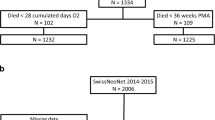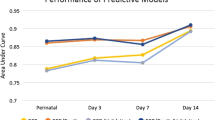Abstract
The paper presents Bronchopulmonary Dysplasia, BPD, prediction for extremely premature infants after their first week of life using LR (Logit Regression). Presented models give accuracy up to 84.6% using only three independent variables and 81.7% with two of them. That novelty was possible to achieve thanks to unique use of arterial flows measurements, which are not a common clinical practice. That original data was collected thanks to the Neonatal Intensive Care Unit of The Department of Pediatrics at Jagiellonian University Medical College. The main pulmonary artery (MPA) and patent ductus arteriosus (PDA) flows were considered as predictors. Beyond classic statistic significance analysis and LR forecast paper presents some other results and discussion, which give an outlook on possible repeatability of results and its quality on some other’s patients data set.
Access this chapter
Tax calculation will be finalised at checkout
Purchases are for personal use only
Similar content being viewed by others
References
Ambalavanan, N., Van Meurs, K.P., Perritt, R., Carlo, W.A., Ehrenkranz, R.A., Stevenson, D.K., Lemons, J.A., Poole, W.K., Higgins, R.D.: Predictors of death or bronchopulmonary dysplasia in preterm infants with respiratory failure. J. Perinatol. 28(6), 420–426 (2008). https://doi.org/10.1038/jp.2008.18
Bhering, C.A., Mochdece, C.C., Moreira, M.E., Rocco, J.R., Sant’Anna, G.M.: Bronchopulmonary dysplasia prediction modelfor 7-day-old infants. Jornal de pediatria 83(2), 163–170 (2007). https://doi.org/10.1590/S0021-75572007000200011
Bhutani, V.K., Abbasi, S.: Relative likelihood of bronchopulmonary dysplasia based on pulmonary mechanics measured in preterm neonates during the first week of life. J. Pediatr. 120(4), 605–613 (1992). https://doi.org/10.1016/S0022-3476(05)82491-6
Corcoran, J., Patterson, C., Thomas, P., Halliday, H.: Reduction in the risk of bronchopulmonary dysplasia from 1980–1990: results of a multivariate logistic regression analysis. Eur. J. Pediatr. 152(8), 677–681 (1993). https://doi.org/10.1007/BF01955247
Cunha, G.S., Mezzacappa-Filho, F., Ribeiro, J.D.: Risk factors for bronchopulmonary dysplasia in very low birth weight newborns treated with mechanical ventilation in the first week of life. J. Trop. Pediatr. 51(6), 334–340 (2005). https://doi.org/10.1093/tropej/fmi051
Farstad, T., Bratlid, D., Medbø, S., Markestad, T.: Bronchopulmonary dysplasia-prevalence, severity and predictive factors in a national cohort of extremely premature infants. Acta Paediatr. 100(1), 53–58 (2011). https://doi.org/10.1111/j.1651-2227.2010.01959.x
Gilbert, R., Keighley, J.: The arterial-alveolar oxygen tension ratio. an index of gas exchange applicable to varying inspired oxygen concentrations. Am. Rev. Respir. Dis. 109(1), 142 (1974)
Groothuis, J.R., Makari, D.: Definition and outpatient management of the very low-birth-weight infant with bronchopulmonary dysplasia. Adv. Therapy 29(4), 297–311 (2012). https://doi.org/10.1007/s12325-012-0015-y
Jobe, A.H.: The new bronchopulmonary dysplasia. Curr. Opin. Pediatr. 23(2), 167 (2011). https://doi.org/10.1097/MOP.0b013e3283423e6b
Kim, Y.D., Kim, E.A.R., Kim, K.S., Pi, S.Y., Kang, W.: Scoring method for early prediction of neonatal chronic lung disease using modified respiratory parameters. J. Korean Med. Sci. 20(3), 397–401 (2005). https://doi.org/10.3346/jkms.2005.20.3.397
Kim, Y.D., Kim, K.S., Kim, E.A.R., Lee, J.J., Park, S.J., Pi, S.Y.: Perinatal risk factors for the development of bronchopulmonary dysplasia in premature infants less than 32 weeks’ gestation. J. Korean Soc. Neonatol. 8(1), 78–93 (2001)
Laughon, M.M., Langer, J.C., Bose, C.L., Smith, P.B., Ambalavanan, N., Kennedy, K.A., Stoll, B.J., Buchter, S., Laptook, A.R., Ehrenkranz, R.A., et al.: Prediction of bronchopulmonary dysplasia by postnatal age in extremely premature infants. Am. J. Respir. Crit. Care Med. 183(12), 1715–1722 (2011). https://doi.org/10.1164/rccm.201101-0055OC
Marshall, D.D., Kotelchuck, M., Young, T.E., Bose, C.L., Kruyer, L., O’Shea, T.M.: Risk factors for chronic lung disease in the surfactant era: a north carolina population-based study of very low birth weight infants. Pediatrics 104(6), 1345–1350 (1999). https://doi.org/10.1542/peds.104.6.1345
Ochab, M., Wajs, W.: Bronchopulmonary dysplasia prediction using support vector machine and LIBSVM. In: Proceedings of the 2014 Federated Conference on Computer Science and Information Systems, Annals of Computer Science and Information Systems, vol. 2, pp. 201–208. IEEE (2014). https://doi.org/10.15439/2014F111
Ochab,M.,Wajs,W.: Bronchopulmonary dysplasia prediction using support vector machine and logit regression. Inf. Technol. Biomed. 4, 365–374 (2014). https://doi.org/10.1007/978-3-319-06596-0_34
Ochab, M., Wajs, W.: Expert system supporting an early prediction of the bronchopulmonary dysplasia. Comput. Biol. Med. 69, 236–244 (2016). https://doi.org/10.1016/j.compbiomed.2015.08.016
Oh, W., Poindexter, B., Perritt, R., Lemons, J., Bauer, C., Ehrenkranz, R., Stoll, B., Poole, K., Wright, L.: Neonatal research network. association between fluid intake and weight loss during the first ten days of life and risk of bronchopulmonary dysplasia in extremely low birth weight infants. J. Pediatr. 147(6), 786–790 (2005). https://doi.org/10.1016/j.jpeds.2005.06.039
Rojas, M.A., Gonzalez, A., Bancalari, E., Claure, N., Poole, C., Silva-Neto, G.: Changing trends in the epidemiology and pathogenesis of neonatal chronic lung disease. J. Pediatr. 126(4), 605–610 (1995). https://doi.org/10.1016/S0022-3476(95)70362-4
Sinkin, R.A., Cox, C., Phelps, D.L.: Predicting risk for bronchopulmonary dysplasia: selection criteria for clinical trials. Pediatrics 86(5), 728–736 (1990)
Sosenko, I., Bancalari, E.: New developments in the pathogenesis and prevention of bronchopulmonary dysplasia. The Newborn Lung: Neonatology Questions and Controversies: Expert Consult-Online and Print, pp. 217–233 (2012)
Stoch, P.: Zastosowanie narzędzi statystycznych i matematycznych metod sztucznej inteligencji do predykcji wystąpienia dysplazji oskrzelowo-płucnej u noworodków. Praca doktorska , Akademia Górniczo-Hutnicza, Kraków, pp. 60–72 (2007). (in Polish)
Stoll, B.J., Hansen, N.I., Bell, E.F., Shankaran, S., Laptook, A.R., Walsh, M.C., Hale, E.C., Newman, N.S., Schibler, K., Carlo, W.A., et al.: Neonatal outcomes of extremely preterm infants from the nichd neonatal research network. Pediatrics 126(3), 443–456 (2010). https://doi.org/10.1542/peds.2009-2959
Subhedar, N., Hamdan, A., Ryan, S., Shaw, N.: Pulmonary artery pressure: early predictor of chronic lung disease in preterm infants. Arch. Dis. Childhood-Fetal Neonatal Ed. 78(1), F20–F24 (1998). https://doi.org/10.1136/fn.78.1.F20
Tapia, J.L., Agost, D., Alegria, A., Standen, J., Escobar, M., Grandi, C., Musante, G., Zegarra, J., Estay, A., Ramírez, R.: Bronchopulmonary dysplasia: incidence, risk factors and resource utilization in a population of south-american very low birth weight infants. Jornal de pediatria 82(1), 15–20 (2006). https://doi.org/10.1590/S0021-75572006000100005
Walsh, M.C., Szefler, S., Davis, J., Allen, M., Van Marter, L., Abman, S., Blackmon, L., Jobe, A.: Summary proceedings from the bronchopulmonary dysplasia group. Pediatrics 117(Supplement 1), S52–S56 (2006). https://doi.org/10.1542/peds.2005-0620I
Author information
Authors and Affiliations
Corresponding author
Editor information
Editors and Affiliations
Rights and permissions
Copyright information
© 2019 Springer International Publishing AG, part of Springer Nature
About this paper
Cite this paper
Wajs, W., Kruczek, P., Szymański, P., Wais, P., Ochab, M. (2019). Arterial Flows in Bronchopulmonary Dysplasia Prediction. In: Pietka, E., Badura, P., Kawa, J., Wieclawek, W. (eds) Information Technology in Biomedicine. ITIB 2018. Advances in Intelligent Systems and Computing, vol 762. Springer, Cham. https://doi.org/10.1007/978-3-319-91211-0_24
Download citation
DOI: https://doi.org/10.1007/978-3-319-91211-0_24
Published:
Publisher Name: Springer, Cham
Print ISBN: 978-3-319-91210-3
Online ISBN: 978-3-319-91211-0
eBook Packages: Intelligent Technologies and RoboticsIntelligent Technologies and Robotics (R0)




